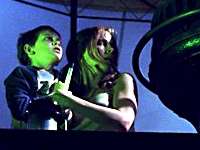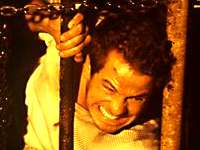


Darkness Falls - 2002 - Jonathan Lieberman-Director & John Hegeman-Producer



![]() Viewed on 13 May 03. When we bought our tickets to see DARKNESS FALLS we actually believed that the previews and posters had accurately portrayed it as a horror movie. But imagine how surprised and delighted we were when we found that instead, it is a film about how to make a horror movie. DARKNESS FALLS is a carefully spelled-out blueprint - anyone seeing this film will be able to go out, buy a camera and make a horror film. Guaranteed success, first time out. But just in case you can't see this film while it is in Bangkok, I will pass on to you what Director Jonathan Lieberman wanted you to understand about horror movie-making before you actually go out and start filming.
Viewed on 13 May 03. When we bought our tickets to see DARKNESS FALLS we actually believed that the previews and posters had accurately portrayed it as a horror movie. But imagine how surprised and delighted we were when we found that instead, it is a film about how to make a horror movie. DARKNESS FALLS is a carefully spelled-out blueprint - anyone seeing this film will be able to go out, buy a camera and make a horror film. Guaranteed success, first time out. But just in case you can't see this film while it is in Bangkok, I will pass on to you what Director Jonathan Lieberman wanted you to understand about horror movie-making before you actually go out and start filming.
1. First we start with some historical references or documents that allude to the horrors that will soon follow. This sets the scene: gives it some 'credentials' and allows the audience to "step through the looking glass" into suspended disbelief. 2. Next have one of the protagonists wake in a panic from a horrible nightmare by sitting bolt-upright in bed. (This is next to impossible to do even when you are already awake - try it sometime...) This person must be sweating profusely, even though he was sleeping with all the bedroom windows open (mandatory), and you need to have either a full moon along with a strong wind blowing the curtains, or a violent thunderstorm to complete this scene. 3. You will need several long silences which are broken by sudden loud noises. This will always have the audience bolting in their seats. All of the loud noises have to be 'harmless' false alarms, except near the end when the 'Bogey Man' finally does come to the party. 4. Make sure there are strange noises in the building at night which are investigated by one of the cast. They may not switch on any lights while checking out the horrifying sounds, like any human being with a two-digit I.Q. would. However a flashlight is optional. 'Scary', wavering organ music is mandatory for this scene.. 5. Another mandatory scene is where they absolutely have to stick together to survive, but for the dumbest reason you can possibly think of, they decide to split up - and, of course, get picked off one-by-one. Its better if you remind the audience beforehand that splitting up is the worst possible choice, as there may be a few cretins out there that won't get it. 6. Sooner or later, one of the cast will find himself in a dark room with the 'Bogey Man' lurking somewhere near. That person is designated as "Backward-Walking Fodder" - there's one in every movie, so there will have to be one in yours. He is called this because he is so afraid the 'Bogey Man' will come up behind him, that he naturally turns around and starts backing through the darkened room, until the inevitable backing into the 'Bogey Man' happens. At that point, he becomes 'fodder', if you get our drift. This will take hours of rehearsing, and re-shoots as it is almost impossible to walk backward through darkened, cluttered rooms without falling repeatedly on one's backside. 7. One of the cast must be a pre-teen 'Haley Joel Osment' type, a prescient kid like the one they had in the Sixth Sense, who "knows things". This 'sucks in' all those in the audience who believe in telepathy. 8. Use 'scary' lighting shining up into everyone's faces whenever possible. This is an oldie but a goodie dating back at least to Bela Lugosi in White Zombie (1932), but it still works. 9. At least 90% of the film has to take place at night when everything is intrinsically 'scarier' - but you already knew that. However, the last scene has to be in bright morning sunlight (see below). 10. The last scene is very important - you need to have some small, almost inconsequential event which happens after evil has finally been foiled and "all is well again with the world", and birds are singing in the bright sunlight. This almost-unnoticed event will tell the audience that the evil is in fact still lurking somewhere 'out there'. This causes kids to have nightmares and is a good 'sequel prep'. Alternatively, one last silence-followed-by-a-loud-noise can be substituted - this causes nervous laughter in both the cast and the audience.
So, there you have it - ten easy steps to cinematic horror-movie success - Hollywood style. This guaranteed horror-formula would even transform the screenplay for Mary Poppins into a heart-stopping horror flick. See you at the Oscars.
Enduring Line or Phrase: "Crazy is what I used to be."
 To print this page: *CLICK*
To print this page: *CLICK* ![]() .
© 2003, Bangkok Eyes / bangkokeyes.com
.
© 2003, Bangkok Eyes / bangkokeyes.com